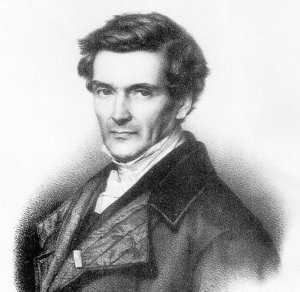- Gaspard-Gustave Coriolis
Infobox Scientist
name = Gaspard-Gustave de Coriolis
box_width =
image_width =150px
caption = Gaspard-Gustave de Coriolis
birth_date = 21 May 1792
birth_place =Paris
death_date = 19 September 1843
death_place =
residence =
citizenship =
nationality =France
ethnicity =
field =Mathematics ,Physics
work_institutions =École Polytechnique
alma_mater =
doctoral_advisor =
doctoral_students =
known_for =Coriolis Effect
author_abbrev_bot =
author_abbrev_zoo =
influences =
influenced =
prizes =
religion =
footnotes =
Gaspard-Gustave de Coriolis or Gustave Coriolis (21 May 1792 – 19 September 1843) was a Frenchmathematician ,mechanical engineer andscientist . He is best known for his work on theCoriolis Effect . Coriolis was the first to coin the term "work" for the product of force and distance. [cite book | last = Jammer | first = Max | title = Concepts of Force | publisher = Dover Publications, Inc. | year = 1957 | id = ISBN 0-486-40689-X]Biography
Coriolis was born in
Paris . In 1816 he became a tutor at theÉcole Polytechnique . Here he did experiments onfriction andhydraulics .In 1829 Coriolis published a textbook, "Calcul de l'Effet des Machines" ("Calculation of the Effect of Machines"), which presented mechanics in a way that could readily be applied by industry. In this period the correct expression for
kinetic energy , frac{1}{2}mv^2, and its relation tomechanical work became established.During the following years Coriolis worked to extend the notion of kinetic energy and work to rotating systems. The first of his papers, "Sur le principe des forces vives dans les mouvements relatifs des machines" (On the principle of kinetic energy in the relative motion in machines), was read to the Académie des Sciences (Coriolis 1832). Three years later came the paper that would make his name famous, "Sur les équations du mouvement relatif des systèmes de corps" (On the equations of relative motion of a system of bodies) (Coriolis 1835). Coriolis's papers do not deal with the atmosphere or even the rotation of the earth, but with the transfer of energy in rotating systems like waterwheels.
In 1835 he published a mathematical work on collisions of spheres: "Théorie Mathématique des Effets du Jeu de Billard", considered a classic on the subject.cite book |title=Byrne's Advanced Technique in Pool and Billiards |author=Robert Byrne |url=http://books.google.com/books?id=tA_v24zx7J8C&pg=PT64&dq=%22Gaspard-Gustave+Coriolis%22&lr=&as_brr=0&sig=U-RrDhROKbiC4x2Ddw-lJDUcuYQ
isbn=0156149710 |year=1990 |page=p. 49 |publisher=Harcourt Trade ] cite book |title=Théorie mathématique des effets du jeu de billard ; suivi des deux celebres memoires publiés en 1832 et 1835 dans le "Journal de l'École Polytechnique":Sur le principe des forces vives dans les mouvements relatifs des machines & Sur les équations du mouvement relatif des systèmes de corps |isbn=2876470810 |author=G Coriolis |publisher=Éditions Jacques Gabay |year=1990|url=http://gallica.bnf.fr/ark:/12148/bpt6k29318f.notice |edition=Originally published by Carilian-Goeury, 1835 ]Coriolis's name began to appear in the meteorological literature at the end of the 19th century, although the term "
Coriolis force " was not used until the beginning of the 20th century. Today, the name Coriolis has become strongly associated with meteorology, but all major discoveries about the general circulation and the relation between the pressure and wind fields were made without knowledge about Gaspard Gustave Coriolis.Coriolis became also professor at
École centrale Paris . He died at the age of 51 inParis .hiReferences
Further reading
* Persson, A., 1998 "How do we understand the Coriolis Force?" Bull. Amer. Meteor. Soc. 79, 1373-1385.
[http://www.aos.princeton.edu/WWWPUBLIC/gkv/history/Persson98.pdf 374 KB PDF document of the above article]External links
*
Wikimedia Foundation. 2010.
